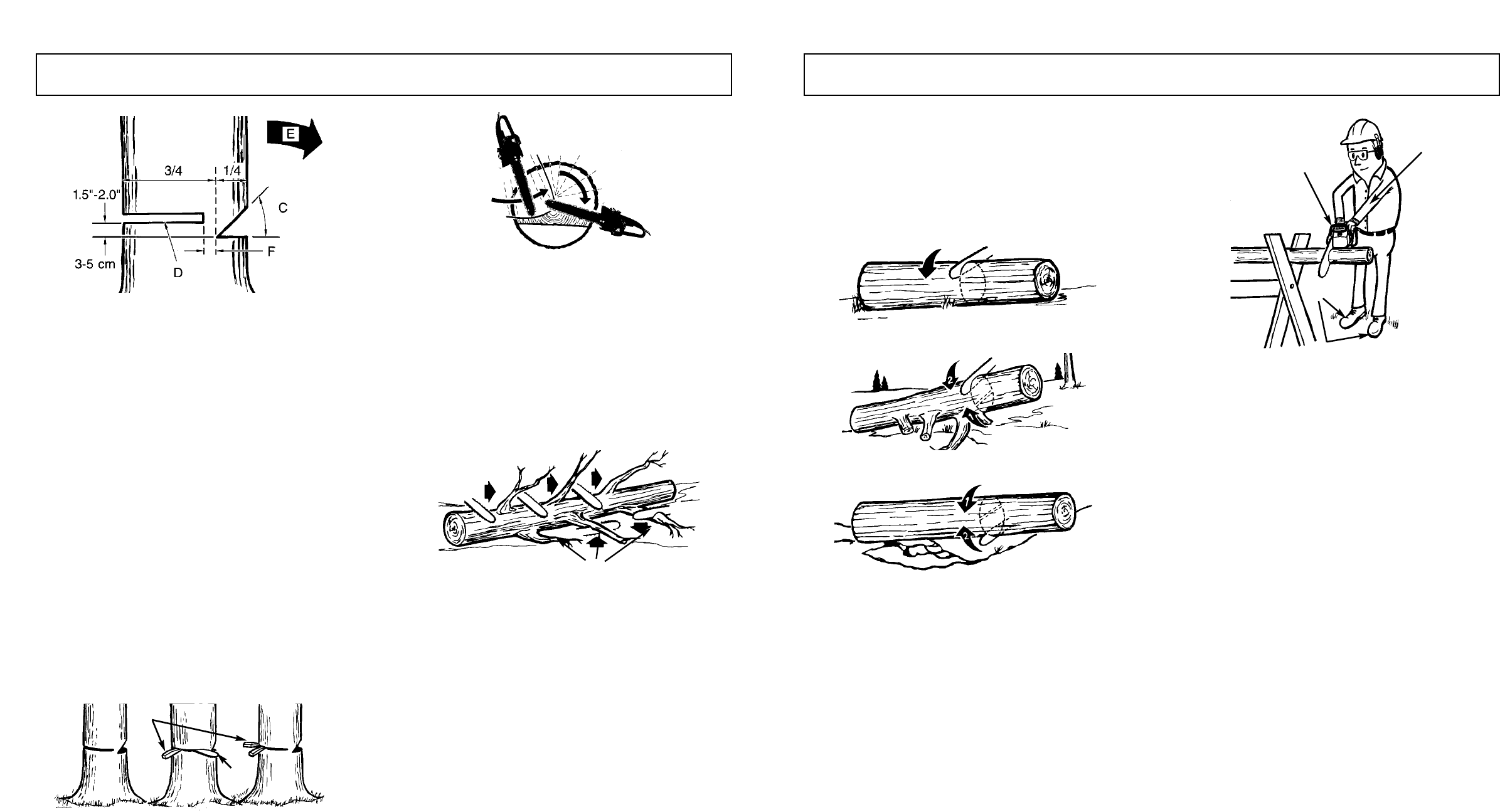
16 17
5 - GENERAL CUTTING INSTRUCTIONS
Never saw completely through the trunk. Always leave a
hinge. The hinge guides the tree. If the trunk is completely
cut through, control over the felling direction is lost.
Insert a wedge or felling lever in the cut well before the tree
becomes unstable and starts to move. This will prevent the
guide bar from binding in the felling cut if you have mis-
judged the falling direction. Make sure no bystanders have
entered the range of the falling tree before you push it over.
WARNING
Before making the final cut, always recheck the area for
bystanders, animals or obstacles.
FELLING CUT:
1. Use wooden or plastic wedges (G) to prevent binding
the bar or chain (H) in the cut. Wedges also control
felling (Figure 5-2C).
2. When diameter of wood being cut is greater than the
bar length, make 2 cuts as shown (Figure 5-2D).
WARNING
As the f
elling cut gets close to the hinge, the tree should
begin to fall.When tree begins to fall, remove saw from cut,
stop engine, put chain saw down, and leave area along
retreat path (Figure 5-2A).
5-3. LIMBING
Limbing a tree is the process of removing the branches
from a fallen tree. Do not remove supporting limbs (A) until
after the log is bucked (cut) into lengths (Figure 5-3A).
Branches under tension should be cut from the bottom up
to avoid binding the chain saw.
WARNING
Never cut tree limbs while standing on tree trunk.
5-4. BUCKING
Buc
king is cutting a f
allen log into lengths. Make sure you
have a good footing and stand uphill of the log when cutting
on sloping g
round. If possible, the log should be supported
so that the end to be cut off is not resting on the g
round.
If
the log is supported at both ends and you must cut in the
middle
, make a downward cut halfway through the log and
then mak
e the undercut.
This will pre
v
ent the log from
pinching the bar and chain. Be careful that the chain does
not cut into the g
round when bucking as this causes rapid
dulling of the chain.
When bucking on a slope, always stand on the uphill side.
1. Log supported along entire length: Cut from top (over-
b
uc
k), being careful to a
v
oid cutting into the ground
(Figure 5-4A).
2. Log supported on 1 end: First, cut from bottom (under-
b
uc
k) 1/3 diameter of log to a
v
oid splintering. Second,
cut from above (overbuck) to meet first cut and avoid
pinching (Figure 5-4B).
5 - GENERAL CUTTING INSTRUCTIONS
3. Log supported on both ends: First, overbuck 1/3 diam-
eter of log to avoid splintering. Second, underbuck to
meet first cut and avoid pinching (Figure 5-4C).
NO
TE:
The best w
ay to hold a log while bucking is to use a
sawhorse. When this is not possible, the log should be
raised and supported by the limb stumps or by using sup-
porting logs. Be sure the log being cut is securely support-
ed.
5-5.BUCKING USING A SAWHORSE
For personal safety and ease of cutting, the correct position
for vertical bucking is essential (Figure 5-5A).
VERTICAL CUTTING:
A.
Hold the sa
w fir
mly with both hands and k
eep the sa
w
to the right of your body while cutting.
B. Keep the left arm as straight as possible.
C
.
K
eep w
eight on both f
eet.
CAUTION
While the sa
w is cutting, be sure the chain and bar are
being properly lubricated.
5-2B
5-2D
5-3A
A
5-4A
5-4B
5-4C
5-5A
B
A
C
5-2C
G
H


















